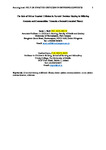The Role of Felt or Enacted Criticism in Parents’ Decision Making in Differing Contexts and Communities: Toward a Formal Grounded Theory
| dc.contributor.author | Neill, Sarah | |
| dc.contributor.author | Coyne, I | |
| dc.date.accessioned | 2020-09-16T15:49:51Z | |
| dc.date.available | 2020-09-16T15:49:51Z | |
| dc.date.issued | 2018-08 | |
| dc.identifier.issn | 1074-8407 | |
| dc.identifier.issn | 1552-549X | |
| dc.identifier.uri | http://hdl.handle.net/10026.1/16372 | |
| dc.description.abstract |
<jats:p>Felt or enacted criticism was identified as a significant influence on White British parents’ decision making during acute childhood illness in a substantive grounded theory “Containing acute childhood illness within family life.” These parents sought to avoid further criticism, sometimes leading to delayed consultation. Using Glaserian grounded theory principles, we conducted a secondary analysis of data from three studies, to establish the transferability and modifiability of the original theory to other settings and communities in Ireland and England. Felt or enacted criticism was found to operate across the childhood age range, social groups, and settings. Parent’s strategies to avoid criticism reduced contacts with health professionals, access to support and, more worryingly, communication about their child’s health. These findings demonstrate the wider applicability, or “work” in Glaser’s terms, of the concept in the English speaking Western world. Findings indicate the need for nurses to identify and mitigate sources of criticism.</jats:p> | |
| dc.format.extent | 443-469 | |
| dc.format.medium | Print-Electronic | |
| dc.language | en | |
| dc.language.iso | eng | |
| dc.publisher | SAGE Publications | |
| dc.subject | grounded theory | |
| dc.subject | childhood illness | |
| dc.subject | doctor-patient communication | |
| dc.subject | nurse-patient communication | |
| dc.subject | criticism | |
| dc.title | The Role of Felt or Enacted Criticism in Parents’ Decision Making in Differing Contexts and Communities: Toward a Formal Grounded Theory | |
| dc.type | journal-article | |
| dc.type | Journal Article | |
| plymouth.author-url | https://www.webofscience.com/api/gateway?GWVersion=2&SrcApp=PARTNER_APP&SrcAuth=LinksAMR&KeyUT=WOS:000441594500006&DestLinkType=FullRecord&DestApp=ALL_WOS&UsrCustomerID=11bb513d99f797142bcfeffcc58ea008 | |
| plymouth.issue | 3 | |
| plymouth.volume | 24 | |
| plymouth.publication-status | Published | |
| plymouth.journal | Journal of Family Nursing | |
| dc.identifier.doi | 10.1177/1074840718783488 | |
| plymouth.organisational-group | /Plymouth | |
| plymouth.organisational-group | /Plymouth/Faculty of Health | |
| plymouth.organisational-group | /Plymouth/Faculty of Health/School of Nursing and Midwifery | |
| plymouth.organisational-group | /Plymouth/REF 2021 Researchers by UoA | |
| plymouth.organisational-group | /Plymouth/REF 2021 Researchers by UoA/UoA03 Allied Health Professions, Dentistry, Nursing and Pharmacy | |
| plymouth.organisational-group | /Plymouth/Research Groups | |
| plymouth.organisational-group | /Plymouth/Research Groups/Plymouth Institute of Health and Care Research (PIHR) | |
| plymouth.organisational-group | /Plymouth/Users by role | |
| plymouth.organisational-group | /Plymouth/Users by role/Academics | |
| dc.publisher.place | United States | |
| dc.identifier.eissn | 1552-549X | |
| dc.rights.embargoperiod | Not known | |
| rioxxterms.versionofrecord | 10.1177/1074840718783488 | |
| rioxxterms.licenseref.uri | http://www.rioxx.net/licenses/all-rights-reserved | |
| rioxxterms.type | Journal Article/Review |


